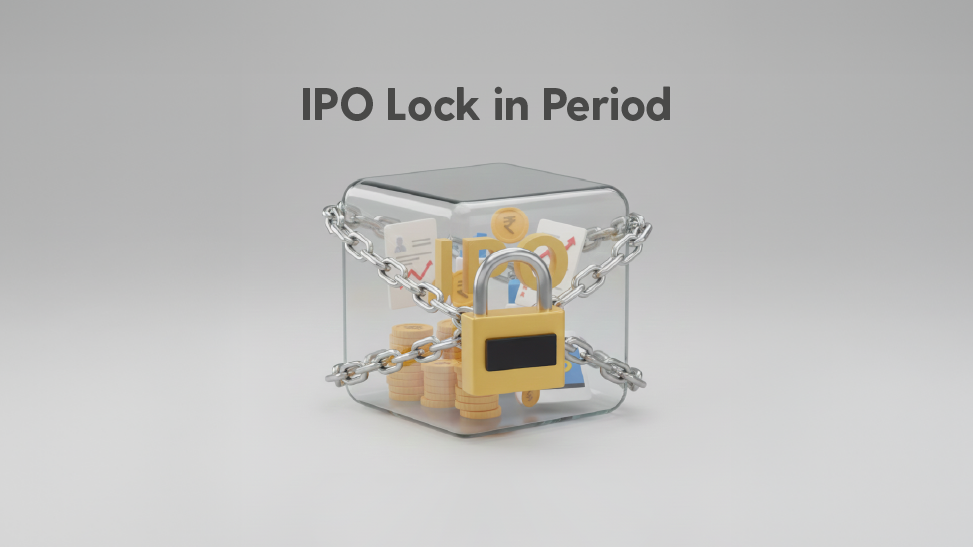IPO Lock in Period: Meaning, IPO Lock-in Period For Retail Investors, SME & Anchor

- Published Date: November 24, 2025
- Updated Date: December 04, 2025
- By Team Choice
When a company launches an IPO, not all shareholders are allowed to sell their holdings immediately after the stock gets listed. This restricted duration is known as the IPO lock-in period. One of the most common queries among investors is: “Is there any lock-in period for IPO in India?”
In this blog, we’ll explain what is lock-in period for IPOs in India, why SEBI mandates it, the lock-in rules for different investor categories, what happens when these lock-ins expire, and the key factors to consider before applying for any IPO in India.
What is an IPO Lock In Period?
An IPO lock-in period is a fixed timeframe after a company lists on the stock market during which certain shareholders are prohibited from selling their shares. These restrictions are primarily placed on promoters, pre-IPO investors, employees (via Employee Stock Option Plans, or ESOPs), and anchor investors, rather than on retail investors who purchase shares during the IPO.
The purpose of the lock-in period for an IPO is to:
- Prevent a large number of shares from hitting the market immediately after listing
- Maintain price stability during the early trading days
- Ensure that key stakeholders stay committed to the company after it goes public
In India, the lock-in rules are defined by SEBI’s ICDR Regulations and vary by investor category (e.g., 18 months for promoters’ minimum contribution, 6 months for pre-IPO investors, 30–90 days for anchor investors).
Why Do Companies Impose Lock In Periods?
Companies impose lock-in periods during an IPO to ensure stability, fairness, and confidence in the newly listed stock. Here’s why they are important:
1. Prevents Immediate Selling Pressure: Without a lock-in, insiders such as promoters, early investors, or employees could sell large quantities right after listing. This sudden increase in supply could cause the stock price to fall sharply.
2. Builds Investor Confidence: Retail and institutional investors feel more secure knowing promoters and pre-IPO investors are committed to staying invested for a minimum period. It indicates that insiders have confidence in the company’s long-term prospects.
3. Ensures Market Stability After Listing: In the initial days of trading, stock prices can be highly volatile. Lock-ins help stabilise the stock by restricting big stakeholders from making significant exits too early.
4. Aligns Long-Term Interests: Lock-in periods ensure promoters, venture capital funds, and other early shareholders remain aligned with the company’s growth trajectory instead of taking short-term gains after listing.
5. Protects New Investors: By controlling early selling pressure, lock-ins create a more orderly market environment, safeguarding the interests of new investors who buy shares in the IPO.
Types of Lock in Periods in an IPO
Different categories of shareholders face different lock-in rules under SEBI’s Issue of Capital and Disclosure Requirements (ICDR) Regulations. These rules ensure stability and fairness in the post-listing period.
1. Promoters’ Lock-in Period:
Promoters are the key stakeholders responsible for building and running the company. Their holdings face the strictest lock-in rules.
- Minimum 20% promoter contribution is locked in for 18 months after listing.
- Promoter holding above this 20% is generally locked in for 6 months, subject to SEBI’s criteria and disclosures in the RHP.
Why: To ensure promoters remain committed to the company and cannot exit immediately after the IPO.
2. Pre IPO Investors Lock in Period:
Pre IPO investors include venture capital funds, private equity funds, AIFs, strategic investors, and others who invested before the company went public.
- Their shares are typically locked in for 6 months from the listing date, unless exempt under specific regulations.
Why: In lock in period for pre ipo investors the early investors often hold shares at a much lower cost, and the lock in prevents large early exits that could disrupt price stability.
3. Employees (ESOP/ESPS Holders) Lock in Period:
Employees who hold shares through Employee Stock Option Plans (ESOPs) or Employee Stock Purchase Schemes (ESPS) may also face lock-ins.
- ESOP/ESPS shares allotted before the IPO are locked in for 6 months, unless exempt under regulation or otherwise disclosed in the RHP.
Why: Employees are considered insiders, and lock-ins help maintain fair trading conditions after listing.
4. Anchor Investors’ Lock in Period:
Anchor investors are institutional investors, like mutual funds, insurance companies, sovereign funds, or FPIs, invited to invest one day before the IPO opens.
SEBI mandates a two-tier lock-in, counted from the date of allotment, not listing:
- 50% of anchor shares: Locked in for 30 days from the date of allotment
- Remaining 50%: Locked in for 90 days
Why: Anchors provide early credibility and stability to the IPO. The lock-in ensures they do not exit immediately and keeps confidence high in the first few weeks of trading.
IPO Lock In for Retail Investors
For an individual investor applying for shares in the Retail Individual Investor (RII) segment of a public issue:
- No Mandatory Lock-in: Once the shares are allotted and successfully listed (credited to the Demat account), the retail investor is free to sell them on the open market immediately, typically on the day of listing.
- Purpose: The regulatory lock-in periods mandated by SEBI's ICDR Regulations are specifically designed to restrict large quantities of shares held by insiders (promoters, pre-IPO investors, employees) and anchor investors from hitting the market immediately. This is done to prevent price volatility and ensure stability.
The Exception (Rare)
The only scenario where a retail investor might indirectly face a selling restriction is if they participate in an IPO via a specific Employee Reserved Portion (as an employee). In that case, the shares allotted may be subject to a 6-month lock-in period, as defined in the prospectus. However, this is not the case for a typical retail investor applying in the public RII segment
Note: The employee reserved portion is not the same as the retail investor category.
What Happens After the IPO Lock In Period Ends?
After the IPO lock-in period ends, the restricted shareholders are finally allowed to sell or transfer their shares. This event can have noticeable effects on the stock and the market. Here’s what typically happens:
1. Increased Supply of Shares in the Market:
Once the lock-in expires, previously restricted shares may enter the market. If many large shareholders decide to sell at the same time, the sudden increase in supply can put downward pressure on the stock price.
2. Potential Short-Term Volatility:
Investors often anticipate selling pressure around lock-in expiry dates. This expectation itself can create volatility leading up to, and immediately after, the unlock event. Stocks may fluctuate as traders try to position themselves. Sometimes, the price drops sharply if heavy selling occurs.
3. Profit Booking by Early Investors:
Pre-IPO investors or anchor investors who bought shares at very low prices may use the first unlock window to book profits. This is a natural behaviour and not necessarily a red flag, but it can influence short-term price movements.
4. Market Reaction Depends on Company Performance:
The impact of unlock events also depends on how the company has performed after listing:
- If the company has grown well, major shareholders may not sell aggressively, leading to minimal impact.
- If performance is weak, more investors may exit, increasing selling pressure and amplifying volatility.
5. Promoter Selling Can Impact Sentiment:
Promoters have long lock-in periods, so when their shares unlock, investors closely watch their actions. If promoters hold or increase their stake, it boosts confidence. If they sell immediately, it may create bearish sentiment.
6. New Investors Should Evaluate Unlock Timelines:
Smart investors monitor lock-in expiry dates as part of IPO evaluation. Heavy unlocks can create temporary dips. Long-term investors can sometimes use these dips as opportunities if the business fundamentals are strong.
SEBI Guidelines for IPO Lock In Period in India
Key SEBI (ICDR) Regulation pointers:
- The ICDR regulations define separate lock-in timelines for promoters, pre-IPO investors, employees, and anchor investors. These rules help ensure transparency and stability in newly listed companies.
- For Demat shares, the company must inform the depositories (NSDL/CDSL) to mark those shares as non-transferable until the lock-in period ends. This prevents any accidental or unauthorised transfers. Depository freezes are lifted automatically upon lock-in expiry, no manual intervention required.
- Promoters are allowed to pledge their locked-in shares, but only under specific conditions laid out by SEBI, mainly for securing loans from banks or financial institutions. Even then, the shares remain non-transferable during the lock-in.
- SEBI has recently shortened some lock-in periods for both promoters and non-promoters, provided the company meets certain criteria (e.g., profitability track record, issue type, or fast-track eligibility). These relaxations are not universal and are always disclosed in the RHP.
What Investors Should Watch Before Investing in an IPO?
Before applying for an IPO, investors should evaluate more than just the hype or subscription numbers. Here are the key things to check:
1. Lock-In Expiry Timeline:
Lock-in periods for promoters, pre-IPO investors, employees, and anchor investors can impact post-listing price movements. A large chunk of shares unlocking soon after listing may create selling pressure. Always review the RHP/DRHP to understand when major unlocks will occur.
2. Strength of the Business Model:
Check whether the company has:
- A sustainable business model
- Clear revenue drivers
- Competitive positioning
Strong fundamentals matter more than short-term demand for the IPO.
3. Financial Performance and Stability:
Review past financial statements to assess:
- Revenue growth
- Profitability
- Debt levels
- Cash flow consistency
Companies with stable growth and improving margins are generally safer bets.
4. Valuation Compared to Peers:
Sometimes IPOs are priced aggressively. Compare the company’s valuation (P/E, P/BV, EV/EBITDA) with industry peers. If the IPO looks overvalued, be cautious, even if the issue is popular.
5. Promoter and Management Quality:
Promoter background, integrity, and experience play a major role in long-term performance. Look for:
- Clean track record
- Consistent leadership
- Low promoter pledging
6. Use of IPO Proceeds:
Understand why the company is raising money. Common reasons include:
- Debt repayment
- Expansion
- Working capital
- Acquisitions
A clear, growth-oriented purpose is a positive sign.
7. Anchor Investor Participation:
Strong anchor investor participation, especially from reputed institutions, signals confidence in the company. However, check their lock-in durations to avoid shocks during unlock events.
8. Market Conditions at the Time of Listing:
Market sentiment plays a major role in listing performance. Even strong IPOs can underperform in weak markets, while moderate ones may list well in bullish phases.
9. Risk Factors Mentioned in the RHP:
Companies disclose all major legal, operational, and financial risks in the prospectus.
Read this section carefully to understand potential challenges.
Conclusion
The IPO lock-in period is a regulatory tool that helps maintain stability in newly listed stocks by restricting certain shareholder categories from selling their shares immediately. In India, SEBI’s rules differentiate between promoters, pre-IPO investors, employees, and anchor investors. While these lock-ins protect the market from sudden supply shocks, their expiry can also trigger volatility. As an investor, being aware of who is locked in, for how long, and when those lock-ins expire is a valuable part of IPO due diligence.
FAQs
1. How does the lock-in period affect share price after listing?
When the lock-in expires, insiders or early investors may sell their shares. If many of them choose to exit, it increases the supply of shares in the market. This can create short-term pressure on the stock price and sometimes lead to a dip. However, the actual impact depends on demand, company performance, and overall market sentiment.
2. Is there any lock-in period for an IPO?
Yes, IPOs in India have lock-in periods, but only for promoters, pre-IPO investors, employees, and anchor investors. Retail investors who receive shares through a public issue do not have a mandatory lock-in period.
3. Why does lock-in expiry cause volatility?
Lock-in expiry introduces the possibility of large shareholders selling their holdings. Traders watch these dates closely because a big sale can temporarily drag the price down. As a result, the days leading up to lock-in expiry often see increased volatility and sharp price movements.
4. How long is the lock-up after an IPO?
The duration varies by shareholder type:
- Promoters: Minimum promoter contribution locked for 18 months; the rest usually lasts 6 months.
- Pre-IPO investors: Typically, 6 months.
- Employees (ESOP shares allotted pre-IPO): Around 6 months (subject to RHP/regulatory exemptions)
- Anchor investors: 30–90 days.
5. What is the 30-day rule for an IPO?
The 30-day rule applies to anchor investors. Under SEBI’s guidelines, 50% of the shares allotted to anchor investors are locked in for 30 days from the date of allotment.
6. What is the 90-day rule for an IPO?
The 90-day rule is the second part of the anchor investor lock-in. The remaining 50% of anchor investor shares are locked in for 90 days, ensuring they remain invested for longer and support post-listing stability.
7. What is the IPO lock-in period for retail investors?
Retail investors who apply through the public issue do not have a lock-in period.
Once the stock is listed on the exchange, they can sell their shares at any time, depending on market conditions.
Recommended for you

Difference Between Equity and Derivatives

A Guide to Algo Trading: Strategies, Risks, and the SEBI Rules
Read this blog to know what is algo trading in stock market, it's benefits & why jiffy is best algorithmic trading platform in India.

FII DII Data - Live Data
